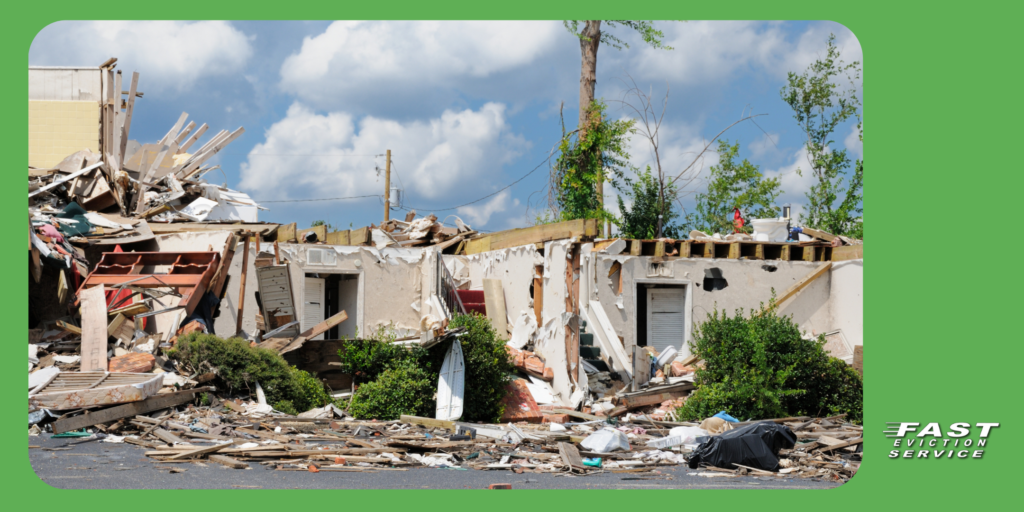Everyone wants to ensure they’ve taken every possible step to be ready for a natural disaster instead of regretting their lack of preparation later. Fortunately, there are numerous measures you can take to safeguard your properties and assets against such events. We’ll begin by discussing the fundamental aspects of preparing for natural disasters, and then we’ll delve into strategies for safeguarding your property, residents, and financial investments when faced with various types of natural disasters, including hurricanes, tornadoes, fires, and earthquakes.

Basic Emergency Checklists for Rental Property
Here are some straightforward safety measures that are applicable across various natural disasters. To ensure the safety of your residents, consider these actions:
- Share emergency plans and procedures with your tenants, either via email or by posting them on the tenant portal.
- Encourage tenants to:
- Maintain a three to seven-day supply of emergency food and water.
- Assemble emergency kits that include essential first aid items.
- Stock up on flashlights along with spare batteries.
- Invest in an emergency radio.
- Designate an out-of-state friend or family member as their emergency contact.
- Prioritize assistance for residents who may be more vulnerable in emergencies.
- Prepare for their pets by having carriers, water bowls, collar identification, extra pet food, and consider getting them microchipped for added safety.
Preparing for Wildfires
Effective preparation prior to a wildfire can potentially safeguard your property. Utilizing fire-resistant building materials whenever feasible is crucial to minimize the risk of structure loss in a fire. The National Fire Protection Association also recommends dividing properties in wildfire-prone regions into four safety zones:
- Zone 1: Encompassing the area within five feet from the property, this zone should remain free of plants, trees, and patio furniture.
- Zone 2: Spanning from 5 to 30 feet around the property, maintain a minimum distance of 18 feet between all trees in this zone.
- Zone 3: Extending from 30 to 60 feet, ensure that all trees are spaced at least 12 feet apart in this area.
- Zone 4: Covering the area from 60 to 100 feet, maintain a minimum spacing of 6 feet between trees.
While clearing up to 100 feet may not be feasible for multifamily property managers, it is advisable to create as much clearance as possible. Nonetheless, it’s essential to recognize that certain wildfires can rapidly spread, covering more than 100 yards per second. In such cases, it may be impossible to protect your property from such a massive natural disaster. Regardless of the situation, if there is a wildfire in your vicinity, always adhere to evacuation guidance. Smoke, intense heat, and flames pose life-threatening risks and should never be underestimated or attempted to be endured.
Preparing for Earthquakes
Safety considerations should be a top priority when constructing buildings in earthquake-prone areas. This involves reinforcing vulnerable elements such as cripple walls, which separate crawl spaces from the rest of the house and may shift during an earthquake. Engineers and professional contractors should evaluate and strengthen walls with additional steel supports as needed.
Residents can also take proactive steps to enhance their safety. They should fasten dressers, bookshelves, and TV stands securely to walls. Any furniture provided with the unit should adhere to earthquake safety standards. Encourage residents to apply the same precautions to their personal belongings.
In the event of an earthquake or any other disaster, residents should diligently follow emergency instructions. If a property sustains damage, it is crucial to communicate your action plan and advise residents not to return home until it has been declared safe to do so.
Natural disasters can occur unexpectedly, but proactive preparation for your properties is essential. Here are steps to enhance your readiness:
Arrange for a certified professional to evaluate your property’s vulnerability to disasters.
Ensure you have appropriate insurance coverage and contemplate implementing mandatory renters insurance for residents.
Maintain a sufficient reserve fund to address major repair expenses.
Use a tenant portal/notification system to spread awareness!

